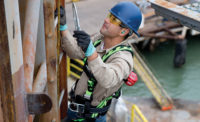

How do you interpret the new labeling?
Under the new scheme, the use of the acronym NRR will be retained, but will now represent a Noise Reduction “range,” as opposed to a single-digit “rating.” The proposed method is still likely to use standardized and controlled testing to show the capability of a given hearing protector, but the new Noise Reduction Range is expected to provide an indication of how much attenuation trained users (the lower number) versus highly motivated trained users (the higher number) can be expected to achieve.While the new method should be more accurate than the current rating, some complain that it will gain accuracy at the expense of simplicity. Where safety managers used to have a single number to deal with, now they will have to contend with a range that focuses on two, or possibly three numbers, depending on how much weight is given to the lab test rating. Many are already asking how they are supposed to use the added information and questioning whether complicating the rating will actually help.
Any rating scheme — whether it uses single numbers or ranges — can be both useful and misleading. In the case of hearing protectors, both the low and the high end of the proposed attenuation range are based on trained users.
That word, “trained,” is important here.
Studies show (see Figure 1 above) that naïve or “untrained” users get much less attenuation from earplugs than trained users do. More recent studies (see Figure 2 below) of real world attenuation show that workers tend to fall into two categories. They either fit the hearing protector well (+ or –5 dB of the published NRR) or very poorly (less than 10 dB of attenuation).
Attenuation is achieved by a good fit versus poor fit of a foam earplug in a worker’s ear. A poor acoustic seal causes no attenuation of hazardous low-frequency noise and little attenuation in high frequencies.
Fit is the key
Certainly, physical factors such as material composition and shape can influence the attenuation level of an earplug. But the fit of the hearing protector is the primary factor in determining how much attenuation it provides. And “fit” is totally under the control of the user, though many users don’t know what a good fit sounds like.That’s where fit-testing systems can help. There are several types of fit-testing systems now on the market that provide this necessary feedback. I’ve personally tested the attenuation on hundreds of individuals, and almost all of them were able learn whether the attenuation is low or high based on a single session.
Training is important, not only to get adequate attenuation but to get consistently appropriate attenuation. Fit testing can help teach the user the difference between good and poor fit of their own earplugs.
Working with the new standards
But in the absence of fit testing, which number should you use? The EPA’s proposed range will improve, but not solve, the issue of accuracy.The conservative approach would be to use the lower of the numbers in the range. For most workers in the United States, daily time-weighted exposure levels are less than 95 dBA. In these cases, attenuation of 10-15 dB is adequate to lower the daily exposure to a safe level.
Generally, exposures are variable throughout the day, but the damage risk criteria are based on daily exposures with auditory rest between exposures. Keeping the overall level throughout the day below 85 dB, or to be safer, 80 dB, is the goal.
Use of the lower attenuation number, however, can increase the risk of overprotection in certain situations. Say, for example, that a worker exposed to 90 dBA of noise uses a hearing protector with the range of 12-30 dB of attenuation. If that worker can consistently achieve a fit that provides 30 dB or more of attenuation, he or she is protected down to 60 dB. That worker may not be able to hear important signals (warning beeps, etc.), especially if the worker has some level of hearing loss. In many work environments, such a level of overprotection could be positively dangerous.
For high intensity noise environments, use of the lower attenuation number may also limit the available selection of hearing protectors. Again, fit testing helps train those workers to consistently attain higher attenuation levels, but more importantly, it allows a closer match between the levels of hazard and protection.
Test for adequate fit
One very low-tech method to test for adequate fit is to perform an “acoustical check.” In a noisy environment, with earplugs inserted, cup your hands over your ears and release. If your earplugs are well seated, you should not notice a significant noise difference.Another method to test for adequate fit was recently developed by NIOSH’s Pittsburgh Research Laboratory. The QuickFitWeb is an online tool to check your hearing protection in a minute or less. It is available online atwww.cdc.gov/niosh/blog/nsb051208_quickfit.html.
Commercially available fit-test systems offer more accuracy and are designed to be an integral part of your overall hearing conservation program. As mentioned, I’ve tried several systems and the immediate feedback they offer employees is valuable to their hearing protection.

